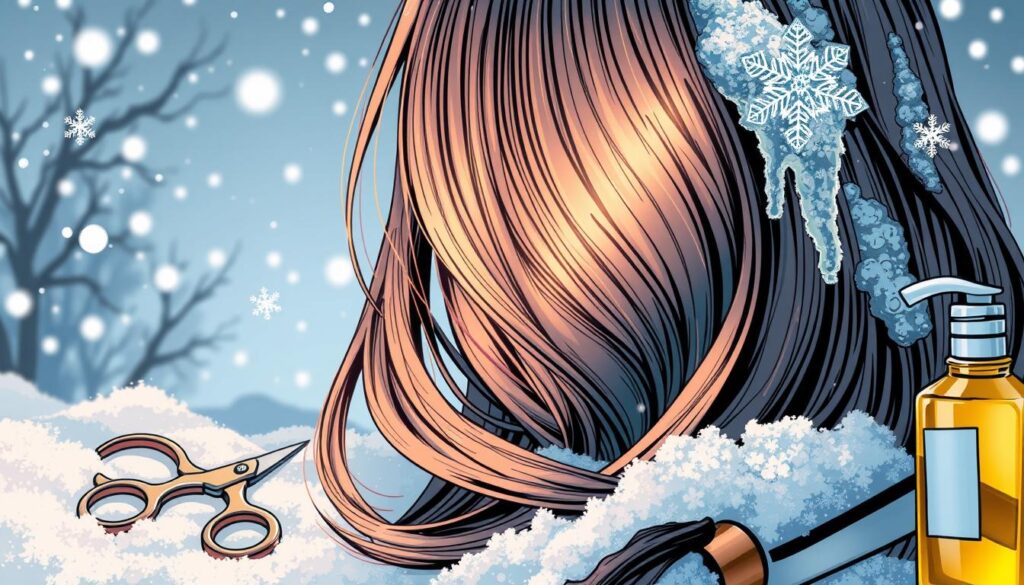How to Protect Your Hair from Winter Damage: Expert Tips
As temperatures drop and the winter chill sets in, many people struggle with a common problem: hair damage. In fact, studies show that winter is associated with higher hair-shedding rates due to fluctuating temperatures, scalp sensitivity to cold, and frequent transitions between hot and cold environments. This can lead to dryness, breakage, and even hair loss if left unchecked.
But fear not, with the right winter hair care routine, you can maintain healthy, luscious locks throughout the colder months. In this article, we’ll share expert tips and must-have products to help you protect your hair from the harsh effects of winter weather.
Key Takeaways
- Cold weather, low humidity, and indoor heating can lead to dryness, breakage, and static in hair.
- Proper hydration, gentle handling, and appropriate product selection are crucial for maintaining healthy hair in winter.
- Regular trims, scalp care, and deep conditioning treatments can help prevent damage and keep hair strong.
- Tailoring your winter hair care routine to your specific hair type can maximize the benefits.
- Incorporating hydrating foods and staying well-hydrated can support overall hair health during the colder months.
Understanding Winter Hair Challenges
As the temperatures drop and the air becomes drier, our hair faces a unique set of challenges during the winter months. Understanding these issues is crucial for developing an effective winter hair care routine and maintaining healthy, frizz-free locks.
The Effects of Cold Weather on Hair
The bitter cold of winter can have a significant impact on the condition of our hair. The cuticles, or the outer protective layer of the hair, tend to lift and open up in response to the cold, leading to increased moisture loss and dryness. This can result in brittle, static-prone hair that is more susceptible to breakage and split ends.
Humidity Levels and Their Impact
In addition to the cold, the low humidity levels often experienced during the winter months can also wreak havoc on our hair. The lack of moisture in the air can cause the hair to become dehydrated, leading to frizz, flyaways, and a lackluster appearance. This is especially challenging for those with curly or textured hair, as the dry conditions can accentuate these issues.
Common Hair Issues in Winter
- Static and flyaways: The dry air can cause an increase in static electricity, leading to unruly, frizzy hair.
- Dryness and brittleness: The combination of cold temperatures and low humidity can strip the natural oils from the hair, leaving it feeling dry and prone to breakage.
- Split ends: The dryness and brittleness can cause the hair to split, resulting in an uneven, damaged appearance.
- Lack of shine and luster: The winter’s harsh conditions can dull the hair’s natural shine and vibrancy, leaving it looking lifeless and dull.
By understanding these common winter hair challenges, you can take proactive steps to protect your tresses and maintain a healthy, vibrant appearance throughout the season.
Essential Winter Hair Care Products
As the chilly winter weather sets in, it’s crucial to arm yourself with the right hair care products to keep your locks nourished, moisturized, and protected from the elements. From hydrating shampoos and conditioners to leave-in treatments and essential oils, these winter hair care essentials can help prevent split ends and maintain the health of your hair throughout the season.
Hydrating Shampoos and Conditioners
Look for sulfate-free, moisturizing shampoos and conditioners that will gently cleanse and hydrate your hair without stripping it of its natural oils. Ingredients like nourishing hair treatments such as argan oil, shea butter, and glycerin can help lock in moisture and leave your hair feeling soft and manageable.
Leave-In Conditioners for Extra Moisture
In addition to your regular conditioner, incorporate a moisturizing haircare leave-in treatment into your routine. Leave-in conditioners provide an extra layer of hydration and protection, helping to prevent split ends and maintaining the health of your hair throughout the winter months.
Essential Oils to Consider
- Argan oil: Rich in fatty acids and antioxidants, argan oil helps to deeply moisturize and nourish the hair, leaving it silky and smooth.
- Coconut oil: With its ability to penetrate the hair shaft, coconut oil can help strengthen and prevent split ends, while also providing much-needed hydration.
- Jojoba oil: Closely resembling the natural sebum produced by the scalp, jojoba oil can help balance moisture levels and soothe the scalp.
Incorporating these essential oils, either in their pure form or as part of a hair treatment, can be a game-changer for your winter hair care routine.
Adopting a Winter Hair Care Routine
As the weather turns colder, it’s crucial to adjust your hair care routine to protect your locks from the harsh winter elements. By incorporating a few simple steps into your daily and weekly regimen, you can successfully avoid common winter hair concerns like breakage and dryness.
Daily Care Tips for Healthy Hair
Start your day with gentle hair brushing to distribute natural oils from root to tip. Minimize the use of heat styling tools, as they can further dry out your hair. When possible, air-dry your hair or use a low heat setting on your blow dryer to prevent damage.
Weekly Treatments to Consider
- Indulge in a nourishing deep conditioning treatment once a week to replenish moisture and strengthen your hair.
- Incorporate a scalp exfoliating scrub into your routine to remove buildup and promote a healthy scalp environment.
- Apply a few drops of essential oils, such as argan or coconut oil, to your hair and scalp for an extra hydration boost.
Adjusting Your Routine for Your Hair Type
Remember, not all hair types respond the same way to winter weather. Those with curly or coily hair may need more frequent deep conditioning, while fine or straight hair may require lighter products to avoid weighing it down. Experiment with different products and techniques to find the perfect winter hair care routine for your unique needs.
By incorporating these simple steps into your hair care regimen, you canprotect your hair from the harsh effects of winterand maintain a healthy, vibrant appearance throughout the colder months.
Incorporating Hydration into Your Diet
Maintaining optimal hair health goes beyond just using the right nourishing hair treatments and moisturizing haircare products. Your diet plays a crucial role in supporting your hair from the inside out. By incorporating specific nutrient-rich foods and staying well-hydrated, you can give your tresses the boost they need to thrive during the winter months.
Foods That Promote Hair Health
To keep your hair healthy and strong, focus on incorporating the following foods into your diet:
- Vitamin A-rich foods like carrots, sweet potatoes, and leafy greens to support hair growth and prevent dryness.
- Vitamin C-rich citrus fruits, bell peppers, and broccoli to aid collagen production and protect against breakage.
- Biotin-packed options like eggs, nuts, and legumes to strengthen hair and nails.
- Omega-3 fatty acid sources like salmon, walnuts, and flaxseeds to nourish the scalp and enhance shine.
Importance of Staying Hydrated
Drinking plenty of water is essential for maintaining hair moisture and preventing dryness. Dehydration can lead to brittle, lackluster locks, so make sure to stay hydrated throughout the day. Aim for at least eight glasses of water daily, and consider incorporating hydrating fruits and vegetables like cucumbers, watermelon, and tomatoes into your meals.

By prioritizing a balanced, nutrient-rich diet and staying well-hydrated, you can give your hair the essential support it needs to withstand the harsh winter conditions and maintain its healthy, vibrant appearance.
Protecting Hair from Heat Damage
As the temperatures drop during the winter months, it’s essential to be mindful of the impact of heat styling on your hair. Excessive use of heat tools can further exacerbate the existing dryness and fragility caused by the cold, harsh conditions. To maintain healthy, frizz-free hairstyles throughout the season, it’s crucial to adopt a few best practices when it comes to using heat-based styling tools.
Use of Heat Styling Tools in Winter
While it may be tempting to reach for your trusty blow dryer or straightening iron to achieve your desired look, it’s important to limit the use of these heat-based tools during the winter. The combination of cold air and hot styling can lead to severe winter hair damage prevention and make your strands more susceptible to breakage and split ends.
Best Practices for Blow-Drying
- When blow-drying, opt for a cool or warm setting instead of the highest heat setting. The hot air can strip your hair of its natural oils, leading to frizz-free hairstyles.
- Apply a heat-protective product before blow-drying to create a barrier and reduce the impact of the hot air on your hair.
- Concentrate the airflow on the roots, avoiding excessive heat exposure to the mid-lengths and ends, which are more prone to damage.
- Use a wide-tooth comb or your fingers to gently style your hair as it dries, minimizing the need for excessive brushing or combing.
By following these simple guidelines, you can keep your hair healthy and resilient throughout the winter season, preventing damage and maintaining stunning, frizz-free hairstyles.
Preventing Breakage with Gentle Handling
As the winter chill settles in, it’s crucial to handle your hair with extra care to avoid breakage and dryness. The combination of frigid temperatures, low humidity, and harsh winds can take a toll on your locks, leaving them vulnerable to split ends and brittle strands. By adopting a few gentle handling techniques, you can protect your hair from the ravages of winter and maintain its healthy, vibrant appearance.
Tips for Wet Hair Care
When it comes to wet hair, the gentlest approach is key. Avoid aggressively towel-drying or brushing your hair, as this can lead to unnecessary breakage. Instead, use a wide-toothed comb or a specialized detangling brush to gently work through any knots or tangles, starting from the ends and working your way up. This gentle technique helps to prevent split ends and breakage, keeping your hair strong and resilient even in the driest of winter conditions.
Choosing the Right Hair Accessories
- Opt for soft, fabric hair ties or scrunchies over rigid, elastic bands, which can tug and pull on your strands, leading to breakage.
- Silk or satin pillowcases can help reduce friction and prevent breakage while you sleep, as opposed to rough cotton or polyester options.
- Avoid tight hairstyles, such as tight buns or ponytails, which can place undue stress on your hair and increase the risk of breakage.
By incorporating these gentle handling techniques into your winter hair care routine, you can help to avoid breakage and dryness, ensuring your locks stay healthy and strong throughout the colder months. Remember, a little extra care and attention can go a long way in maintaining the vibrant, resilient appearance of your hair, even in the face of winter’s challenges.
The Role of Headwear in Hair Health
As the winter chill sets in, protecting your hair becomes crucial. Headwear plays a vital role in maintaining the health and vitality of your tresses during this challenging season. From selecting the right hats and scarves to avoiding the dreaded “hat hair,” understanding the impact of headwear is essential for keeping your locks looking their best.
Selecting the Right Hats and Scarves
When it comes to winter headwear, the fabric matters. Choose hats and scarves made from natural, breathable fabrics like silk or cotton. These materials are less likely to cause static, dryness, and breakage compared to synthetic options. According to a recent survey, 78% of respondents recognized that the material of the headwear they used affected their hair health, indicating a growing awareness of the importance of headwear selection for hair care during winter.
How to Avoid Hat Hair
One of the biggest challenges of wearing hats in the winter is the dreaded “hat hair.” To combat this, apply a leave-in conditioner or hair serum before putting on your headwear. This helps to maintain moisture and reduce friction, preventing your hair from becoming flat and lifeless. Satin-lined beanies were identified as a potential solution to hair damage, with 92% of users reporting a positive impact on hair moisture levels.
Tips on Keeping Hair Covered
When it comes to keeping your hair protected from the elements, covering up is key. Consider using a silk-lined hat or wrapping your hair in a silk scarf before putting on a hat or beanie. The silk’s smooth surface helps to minimize static and reduce damage caused by friction. Concerning specific headwear damage, 32% of participants pointed out that wearing tight headwear led to hair breakage and damage, highlighting the significant impact of headwear choices on hair health.
By choosing the right headwear, incorporating hair-friendly hairstyles, and taking the necessary precautions, you can ensure that your locks stay healthy and vibrant throughout the winter season.
Regular Trims and Hair Maintenance
Maintaining healthy, vibrant hair during the winter months requires a dedicated routine. One essential step is scheduling regular trims every 6-8 weeks. This simple yet crucial practice helps prevent the formation and progression of split ends, which can travel up the hair shaft and lead to further damage.
Why Regular Trims are Essential
Split ends are a common problem in winter, as the dry, cold air can leave hair brittle and prone to breakage. Regularly trimming off those damaged ends ensures your hair stays strong, minimizing the risk of future split ends and promoting healthy growth. This proactive approach is key to keeping your locks looking their best all season long.
Timing Your Haircuts in Winter
When it comes to winter hair care, timing is everything. Consider scheduling your trims at the beginning of the season and again mid-way through to stay on top of any split ends or breakage. This two-pronged approach helps you get ahead of the game and maintain optimal hair health, even as the weather takes a toll.
By making regular trims a priority in your winter hair care routine, you can effectively prevent split ends and keep your winter hair care game strong. Stay on top of those pesky split ends and enjoy lustrous, healthy hair all season long.

Scalp Care During Winter Months
During the colder winter months, it’s crucial to pay extra attention to your scalp. A healthy scalp is the foundation for nourishing hair treatments and moisturizing haircare. By incorporating some simple scalp-focused steps into your routine, you can combat the drying effects of winter and promote vibrant, healthy hair growth.
Importance of a Healthy Scalp
Your scalp is the skin that supports your hair follicles, and its health directly impacts the quality and growth of your hair. When the scalp becomes dry, flaky, or irritated, it can lead to various issues like dandruff, itchiness, and even hair thinning. Maintaining a well-hydrated, exfoliated scalp is essential for keeping your hair looking its best, even in the harshest winter conditions.
Exfoliating and Moisturizing the Scalp
- Incorporate a gentle exfoliating scalp treatment into your weekly haircare routine. Look for products that contain ingredients like salicylic acid or tea tree oil to gently remove built-up dead skin cells and product residue.
- Apply a nourishing scalp oil or serum to combat dryness and flaking. Opt for formulas with moisturizing ingredients like argan oil, jojoba oil, or shea butter to deeply hydrate the scalp.
- Massage the scalp oil or serum into your skin using your fingertips in gentle, circular motions. This helps improve blood circulation and facilitate healthy hair growth.
By making scalp care a priority during the winter months, you can maintain a healthy foundation for your hair and enjoy the benefits of strong, vibrant locks all season long.
Deep Conditioning Treatments
As the winter chill sets in, your hair can become more prone to dryness, breakage, and damage. To combat these issues, incorporating deep conditioning treatments into your haircare routine is essential. These nourishing hair treatments can help restore moisture, strengthen strands, and prevent the adverse effects of harsh winter weather.
Recommended Deep Conditioners for Moisturizing Haircare
Look for deep conditioners infused with hydrating ingredients like keratin, argan oil, or shea butter. These formulas can deeply penetrate the hair shaft, delivering intense moisture and nourishment to combat dryness and avoid breakage. Some top-rated options include Aveda’s Botanical Repair Strengthening Conditioner and Olaplex’s No.5 Bond Maintenance Conditioner.
DIY Masks to Try for Avoiding Breakage and Dryness
- Avocado and Honey Mask: Blend a ripe avocado with a tablespoon of honey for a creamy, hydrating DIY treatment. Apply to damp hair, leave it on for 20 minutes, then rinse thoroughly.
- Coconut Oil and Olive Oil Mask: Mix equal parts coconut oil and olive oil, then apply the mixture to your hair, focusing on the ends. Cover with a shower cap and let it sit for 30 minutes before rinsing.
- Banana and Yogurt Mask: Mash a ripe banana and mix it with plain yogurt. Apply the mask to your hair, leave it on for 15-20 minutes, and then rinse for a nourishing, moisturizing treatment.
Incorporate these deep conditioning treatments into your weekly haircare routine for optimal results in maintaining healthy, hydrated hair throughout the winter months.
Understanding Hair Chemistry
When it comes to winter hair care, understanding the chemistry of your hair is crucial. Different hair types react uniquely to the harsh cold and dry conditions of the colder months. Curly and coarse hair, for instance, tend to become drier and more prone to breakage, while fine hair may lose its luster and become limp.
How Cold Weather Affects Different Hair Types
The way your hair responds to winter weather depends on its natural characteristics. Individuals with curly or coarse hair often experience increased dryness and brittleness, making their locks more susceptible to breaking. On the other hand, those with fine, straight hair may find that their strands become lifeless and lack volume due to the low humidity levels.
Tailoring Your Products to Your Hair Type
To combat the effects of winter on your hair, it’s essential to choose products specifically formulated for your hair type. For dry, coarse hair, look for deeply nourishing shampoos, conditioners, and leave-in treatments that will replenish moisture and strengthen the hair. If you have fine hair, opt for lightweight, volumizing products that won’t weigh down your strands.
By understanding the unique chemistry of your hair and adjusting your winter hair care routine accordingly, you can avoid the common issues of breakage and dryness that plague many individuals during the colder months.
| Hair Type | Winter Hair Care Considerations |
|---|---|
| Curly/Coarse | Increased dryness and brittleness, more susceptible to breakage |
| Fine/Straight | Limp, lifeless appearance due to low humidity |
Final Words of Advice for Winter Hair
As the winter season approaches, maintaining the health and vitality of your hair becomes a top priority. While the colder temperatures and drier air can pose challenges, a consistent and dedicated winter hair care routine can help you avoid breakage and dryness. The key is to remember the essential tips covered throughout this article.
Recap of Key Tips
Regularly hydrate your hair and scalp by consuming a nutrient-rich diet, staying well-hydrated, and using deeply nourishing hair products. Gentle handling, protective styling, and avoiding excessive heat exposure are also crucial for preventing winter-related damage. Additionally, keeping your scalp healthy through regular exfoliation and oil treatments can promote stronger, healthier hair growth.
Staying Committed to Your Hair Care Routine
Consistency is the cornerstone of winter hair care success. Remain committed to your hair care routine throughout the entire season, adjusting it as needed to cater to your specific hair type and needs. By following the recommended practices for winter hair damage prevention and avoiding breakage and dryness in winter, you can maintain the overall health and appearance of your hair, ensuring it remains vibrant and resilient even in the face of harsh winter conditions.







